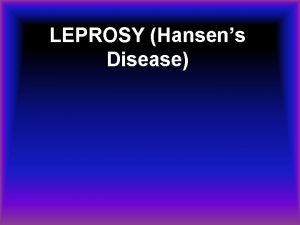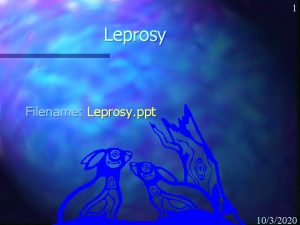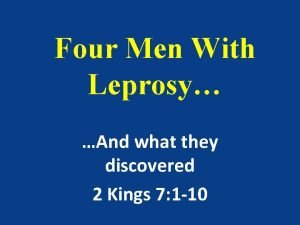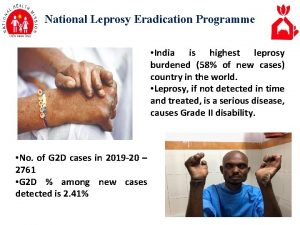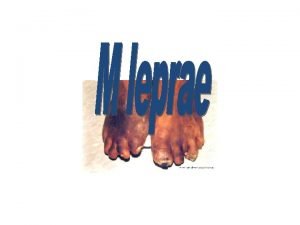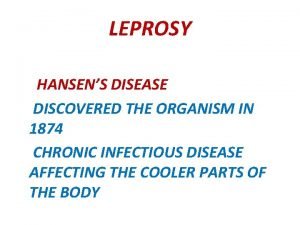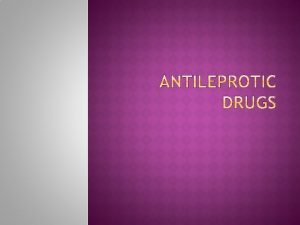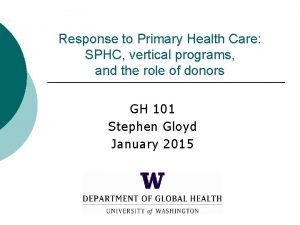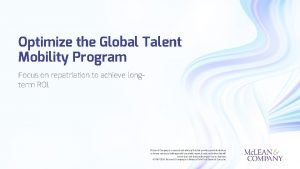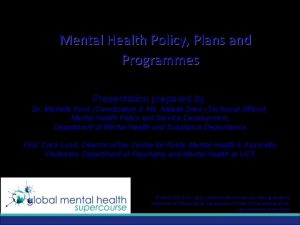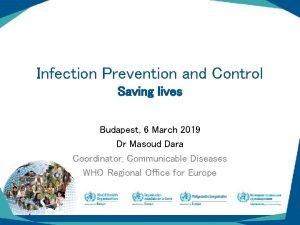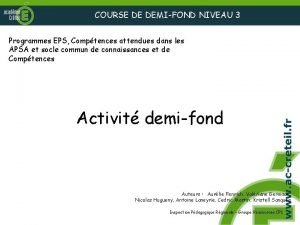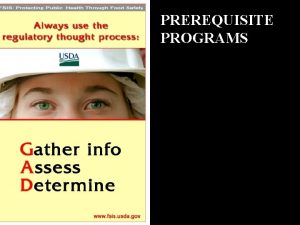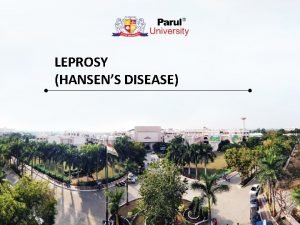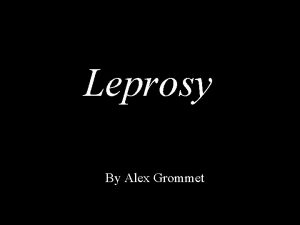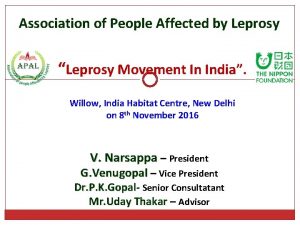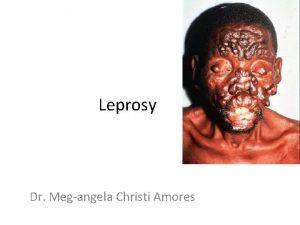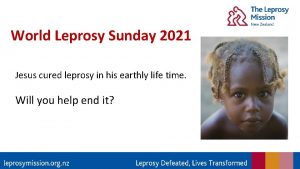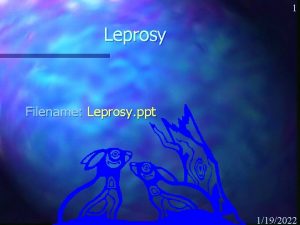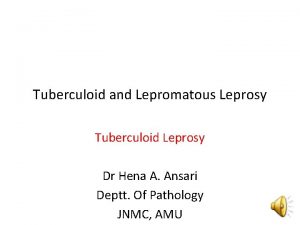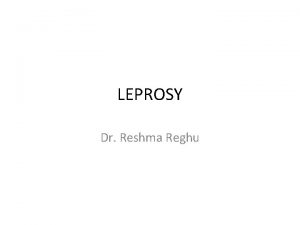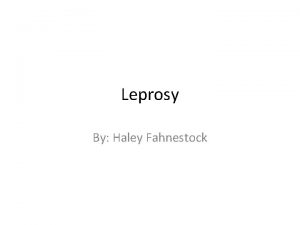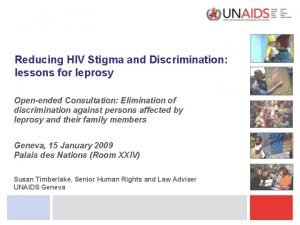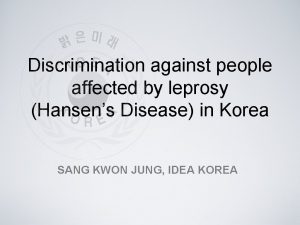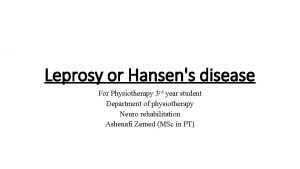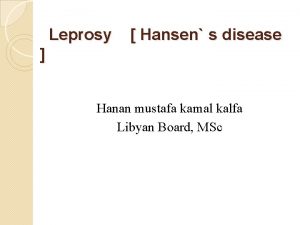INTEGRATION OF DISEASE CONTROL PROGRAMMES Lessons from Leprosy

























- Slides: 25

INTEGRATION OF DISEASE CONTROL PROGRAMMES … Lessons from Leprosy and Malaria

Changing Concept of Health Care Delivery n n n Comprehensive Health Care Basic Health Care Primary Health Care n n n Equitable Distribution Community Participation Inter-sectoral Co-ordination Appropriate technology National Rural Health Mission

Integration n Integration means day to day management, recording and reporting of the disease by general health care staff Does not mean that specialist expertise disappears from the general health service Expertise required within GHS at central & intermediate levels for planning & evaluation , provision of training, technical advice, referral services and research

Integration Equity & accessibility Improved cost effectiveness Long term sustainability Reduction of stigma & discrimination

Dynamics of Integration Community • Awareness of health service facilities • Participation Referral services Health Providers Available for management of difficult/complicated cases • Skilled health manpower • Change in mindset Health services Accessible & available

Basic Principles for Successful Integration n Every health facility should provide MDT services on all working days At least one trained staff should be available in every health facility Adequate amount of MDT drugs should be available free of cost

Basic Principles of Successful Integration n IEC materials should be available for the patient and their family members A simple treatment register should be available Referral services should be available and accessible, and general health staff should know where and how to refer patients

Integration in leprosy means… n n n The ability of peripheral general health workers to suspect leprosy & refer patient to a referral unit Good linkages of peripheral level staff with referral units Referral units including district hospital should diagnose and treat leprosy Good linkages of referral level staff with specialist clinics Continuation of treatment delegated to peripheral health facility

Evolution of NLEP 1955 Launched National Leprosy Control Programme 1983 Launched National Leprosy Eradication Programme and introduced MDT 1991 WHO declaration to eliminate leprosy at global level by 2000 1993 World Bank supported NLEP – I 2001 World Bank supported NLEP – I I 2002 National Health Policy Statement : Elimination of Leprosy by 2005 Integration of Leprosy services with General Health Care System (2002 onwards) 2005 onwards Programme continues with GOI support since January 2005 Dec 2005 Elimination of leprosy as public health problem at national level

Trend of PR & ANCDR

Programme Objectives Further reduce leprosy burden in the country Provide quality leprosy services through GHC system Enhance Disability Prevention & Medical Rehabilitation services Enhance advocacy to reduce stigma and discrimination Capacity building of GHC staff Strengthening monitoring & supervision

Health Care Delivery System in NLEP is an integral part of National Rural Health Mission MOH and FW/ DGHS ↓ Central Leprosy Division ↓ State Health Societies ↓ District Nucleus ↓ PHCs/CHCs ↓ Sub-Centre ↓ Village (AWW, ASHA) Village Health and Sanitation Committee

Integration of NLEP with GHC System n n NLEP remained a vertical programme from 198384 till 2001 -02 Process of integration started with second NLEP project in 2002 -03 27 States/UTs started integration in the 1 st year itself ie. Year 2002 -03 8 States (Bihar, Jharkhand, UP, Uttaranchal, MP, Orissa, Chhattisgarh & West Bengal) completed the Integration process in March 2004.

Process of Integration n n …Contd… Capacity building of GHC staff started in year 199899 75% of the leprosy staff handed over to the GHC system in 2002 -03 25% of the staff retained as vertical component to establish district nucleus to provide backup technical support to GHC staff Leprosy Control Units closed down & service delivery started through primary health care

Process of Integration n …Contd… Temporary hospitalization wards (THW) handed over to the district hospital authorities, keeping 10 beds for leprosy affected persons (LAP) with complications Urban leprosy centres continued to work under overall supervision of the District Leprosy Officers Structural integration took time for different states to relocate the staff

Process of Integration n SLO and DLO in most places look after one or two programmes Programme planning remained with the state and district Leprosy units Integrated decentralised bottom up planning under NRHM started from 2007 -08

Simplified NRHM Annual Planning Process n n 1 st installment of funds is received by the states only in July/August for activities to be undertaken from April of the year For timely release of funds in next year, the planning process should start in August of current year

Simplified NRHM Annual Planning Process July Planning guidelines sent to States & Districts Planni 0 ng Monitoring Stakeholder Consultations per District Drafting District action plans Progress reporting April Budget release from State to District September Progress reporting Submission of Districts plans to NRHM State Progress reporting March August NPCC budget release to States Progress reporting Submission of State plans to NPCC discussions with States; budget approval January November October

Lessons learnt from Leprosy …Contd. . . n Vertical mindset among staff – possessiveness n Resistance from GHC staff n n Apprehension among programme managers about loosing focus & priority to programme Lack of awareness in community about availability of services through primary health care

Lessons learnt from Leprosy n n Inadequate capacity building of health care staff Inadequate staff due to addition of new national health programmes n Poor monitoring & supervision n Inadequate addressal of cultural & physical barriers n Centralized planning

New Paradigms: Integration n Communitization – n Village Health & Sanitation Committee n ASHA n Involvement of PRI n Rogi Kalyan Samiti …Contd…

New Paradigms: Integration …Contd… Flexible Financing n n Untied grants NGOs as implementers Risk pooling – money follows patient More resource for more reforms Improved management through capacity – FMG/DPMU/Accountants NGOs in capacity building NHRC/SHRC/DRG/BRG Continuous skill development support

New Paradigms: Integration Monitor progress against standards n IPHS standards n Facility surveys n Independent monitoring committees Innovation in human resource management n Additional manpower n Emergency services n Multiskilling

Challenges n n Accessibility of Services Meaningful involvement of Community in the: n n n n Planning Implementation Support of health services Planning with other sectors for Inter-sectoral coordination Human resources and development Long term sustainability of the Services Simplified monitorable indicators by the community

Time and Patience are valuable and well appreciated! Thank You!
 Leprosy
Leprosy Lepromin test ppt
Lepromin test ppt Lessons from naaman
Lessons from naaman Four men with leprosy
Four men with leprosy National leprosy eradication programme ppt
National leprosy eradication programme ppt Leprosy
Leprosy Mycobacterium leprae
Mycobacterium leprae Lepra fotos enfermos
Lepra fotos enfermos Leprosy
Leprosy Histoid leprosy ppt
Histoid leprosy ppt Communicable disease and non communicable disease
Communicable disease and non communicable disease Three dimensions of corporate strategy
Three dimensions of corporate strategy Vertical diversification example
Vertical diversification example Example of simultaneous integration
Example of simultaneous integration Vertical health programmes
Vertical health programmes Marcus scheuren
Marcus scheuren Talent mobility program
Talent mobility program National health programme for children in india
National health programme for children in india Fictional programmes
Fictional programmes Designing marketing programmes to build brand equity
Designing marketing programmes to build brand equity Mental health policy, plans and programmes michelle funk
Mental health policy, plans and programmes michelle funk Who guidelines on core components of ipc programmes
Who guidelines on core components of ipc programmes Eps niveau 3
Eps niveau 3 Agriseta funding
Agriseta funding What is prerequisite program
What is prerequisite program Programme de tlvision ce soir
Programme de tlvision ce soir
